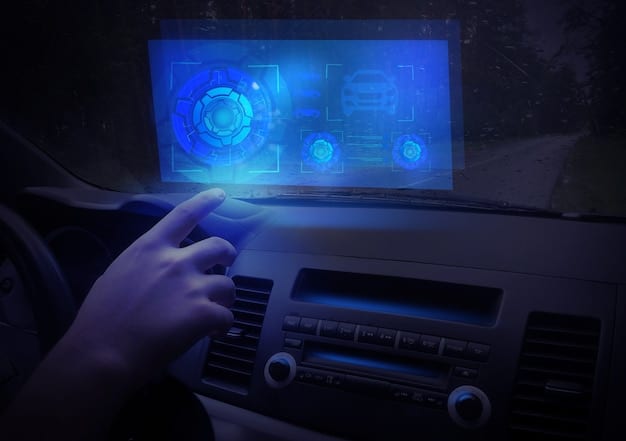Will Biometric Authentication Replace Car Keys by 2027? Future Trends

Biometric authentication, leveraging fingerprints, facial recognition, and other unique biological traits, is increasingly likely to replace traditional car keys by 2027, enhancing security and convenience in vehicle access.
Imagine a world where you never have to fumble for your car keys again. The future of vehicle access is rapidly evolving, and by 2027, biometric authentication might just be the norm, replacing traditional car keys altogether. But is this truly the direction we’re headed?
The Rise of Biometric Technology in Automotive Security
Biometric technology is rapidly transforming various industries, and automotive security is no exception. This technology uses unique biological traits to identify and authenticate individuals, promising enhanced security and convenience compared to traditional methods.
What is Biometric Authentication?
At its core, biometric authentication involves using distinct physiological or behavioral characteristics to verify a person’s identity. This can include fingerprints, facial recognition, iris scans, and even voice recognition. Unlike keys or PIN codes, biometric data is unique to each individual, making it harder to replicate or steal.
Current Implementations in Cars
Several automakers are already experimenting with biometric technology. Hyundai, for example, has implemented fingerprint recognition for door unlocking and engine starting in select models. Tesla uses facial recognition to monitor driver alertness. As technology advances, more sophisticated systems are expected to appear, integrating multiple biometric modalities for enhanced security.
- Enhanced Security: Biometrics offer a higher level of security compared to traditional keys, which can be stolen or duplicated.
- Convenience: No more fumbling for keys – just a touch or a glance to unlock and start your car.
- Personalization: Biometric systems can store individual driver profiles, automatically adjusting seat positions, mirror angles, and infotainment settings.
The integration of biometric technology in automotive security represents a significant leap forward, promising a future where vehicle access is both more secure and more convenient. As technology becomes more sophisticated and cost-effective, widespread adoption is increasingly probable.
Advantages of Biometric Car Access Systems
The transition from traditional car keys to biometric access systems offers numerous benefits, fundamentally changing how we interact with our vehicles. These advantages range from enhanced security to increased convenience and personalization.
Enhanced Security Measures
One of the most significant advantages of biometric systems is their superior security. Unlike traditional keys or key fobs, which can be lost, stolen, or duplicated, biometric data is inherently unique to each individual. This makes it significantly harder for unauthorized individuals to gain access to a vehicle.
Furthermore, biometric systems can be combined with other security measures, such as multi-factor authentication, to provide an even higher level of protection. For instance, a system might require both fingerprint verification and facial recognition to grant access, making it exceptionally difficult for thieves to bypass security.
Convenience and User Experience
Biometric car access systems offer unparalleled convenience. Forget about fumbling for keys in your bag or pocket – simply place your finger on a sensor or glance at a camera to unlock and start your car. This streamlined process can save time and reduce frustration, especially in inclement weather or when carrying multiple items.
Moreover, biometric systems can automatically adjust vehicle settings based on the identified driver. This personalization can include seat positions, mirror angles, climate control preferences, and even infotainment settings, creating a customized driving experience for each user.

Preventing Car Theft with Biometrics
Car theft is a persistent problem, but biometric authentication can significantly reduce the risk. Since biometric data is unique to each individual, it’s virtually impossible for thieves to replicate or bypass the system. This makes it much harder for them to steal a car equipped with biometric access.
- Unique Identification: Biometric data is virtually impossible to replicate, making unauthorized access extremely difficult.
- Multi-Factor Authentication: Combining biometric data with other security measures provides an enhanced level of protection.
- Personalized Settings: Biometric systems can remember driver preferences, such as seat position and climate control.
The advantages of biometric car access systems are clear: enhanced security, unparalleled convenience, and personalized user experience. As technology continues to evolve, these systems are poised to become an integral part of the automotive landscape, offering a safer and more enjoyable driving experience.
Challenges and Obstacles to Widespread Adoption
While the potential of biometric car access systems is immense, several challenges and obstacles stand in the way of widespread adoption. These include technological limitations, privacy concerns, and cost considerations.
Technological Limitations
One of the primary challenges is ensuring the reliability and accuracy of biometric systems in various environmental conditions. Factors such as temperature extremes, humidity, and ambient lighting can affect the performance of fingerprint scanners and facial recognition cameras. Biometric systems need to function flawlessly in all weather conditions.
Additionally, biometric data can change over time due to aging, injury, or other factors. Systems need to be robust enough to adapt to these changes and continue to accurately identify authorized users. Regular updates and recalibration may be required to maintain optimal performance.
Privacy Concerns
The collection and storage of biometric data raise significant privacy concerns. Users may be worried about how their biometric information is being used, stored, and protected. Transparency and robust data security measures are essential to address these concerns. Automakers need to communicate clearly about their data privacy policies.
Cost Considerations
Currently, biometric car access systems are relatively expensive, which limits their availability to high-end vehicles. As technology matures and production volumes increase, the cost is expected to decrease, making it more accessible to a wider range of consumers. However, the initial investment can be a barrier for some buyers.

Addressing Security Vulnerabilities
Like any technology, biometric systems are not immune to hacking or spoofing attempts. Security vulnerabilities must be identified and addressed proactively to prevent unauthorized access. Regular security audits and penetration testing are essential.
- Reliability and Accuracy: Ensuring consistent performance in all environmental conditions.
- Privacy Protection: Addressing concerns about data collection, storage, and usage.
- Cost Reduction: Making biometric systems more accessible to a wider range of consumers.
Overcoming these challenges and obstacles is essential to realizing the full potential of biometric car access systems. By addressing technological limitations, privacy concerns, security vulnerabilities, and cost considerations, the path can be paved for widespread adoption and a future where car keys are a thing of the past.
Consumer Perception and Acceptance of Biometric Technology
Consumer perception and acceptance play a crucial role in the adoption of any new technology, and biometric car access systems are no exception. Understanding how consumers view these systems and addressing their concerns is essential for successful implementation.
Trust and Security Perceptions
For many consumers, trust is a primary factor in adopting biometric technology. They need to be confident that their biometric data is secure and will not be misused. Automakers must prioritize data security and be transparent about their data privacy policies to build trust with consumers.
Consumers also need to understand how biometric systems work and how they enhance security. Education and clear communication can help alleviate concerns about the technology.
Convenience and Ease of Use
While security is important, convenience is also a major driver of adoption. Consumers are more likely to embrace biometric systems if they are easy to use and offer a tangible improvement over traditional methods.
Automakers should focus on designing intuitive and user-friendly biometric systems that seamlessly integrate into the driving experience. This can involve incorporating features such as automatic profile adjustments and personalized settings.
Addressing Privacy Concerns
Privacy concerns are a significant barrier to the adoption of biometric technology. Consumers need reassurance that their biometric data is being handled responsibly and that their privacy is being protected. Automakers should address these concerns head-on by implementing robust data security measures and providing clear and transparent privacy policies.
Building Confidence Through Transparency
Transparency is key to building consumer confidence in biometric systems. Automakers should be open about how biometric data is collected, stored, and used, as well as the security measures in place to protect it. Providing consumers with control over their data can also help alleviate privacy concerns.
- Building Trust: Prioritizing data security and transparency.
- Ensuring Convenience: Designing intuitive and user-friendly systems.
- Addressing Privacy: Implementing robust data security measures.
By understanding and addressing consumer perceptions, automakers can increase the likelihood of widespread adoption of biometric car access systems. Building trust, ensuring convenience, and protecting privacy are essential to making these systems a success.
Potential Challenges and Drawbacks
While biometric authentication offers numerous advantages over traditional car keys, it’s essential to acknowledge potential challenges and drawbacks. These can range from technological limitations and security vulnerabilities to user concerns about privacy and system reliability.
Technological Glitches and Failures
Like any technology, biometric systems are susceptible to glitches and failures. A fingerprint scanner might not recognize a user’s fingerprint due to dirt, moisture, or injury. A facial recognition system could be fooled by a photograph or a sophisticated mask. These potential failures can cause frustration and inconvenience for users.
Security Vulnerabilities
Biometric systems are not immune to hacking or spoofing attempts. If hackers manage to breach the system, they could potentially gain unauthorized access to vehicles. Automakers must continuously monitor and update their security measures to prevent these types of attacks. Regular security audits and penetration testing are essential.
Privacy Concerns and Data Security
The collection and storage of biometric data raise valid privacy concerns. Users may worry about how their biometric information is being used, stored, and protected. Automakers must be transparent about their data privacy policies and implement robust data security measures to safeguard user data. It is crucial to adhere to privacy regulations when dealing with sensitive information.
Cost and Complexity
Implementing biometric authentication systems can be costly and complex. The necessary hardware and software can add to the overall cost of the vehicle. Moreover, integrating these systems seamlessly into existing automotive architecture requires significant engineering expertise. The cost of these systems could potentially limit their availability to high-end vehicles initially.
- System Failures: Potential glitches and malfunctions can cause inconvenience.
- Security Risks: Vulnerabilities to hacking and spoofing attempts.
- Privacy Issues: Concerns about data collection, storage, and usage.
Acknowledging these potential challenges and drawbacks is essential for the successful implementation of biometric car access systems. By addressing these issues proactively, automakers can build user trust and ensure the long-term viability of this technology.
Future Trends and Innovations in Biometric Car Technology
The field of biometric car technology is rapidly evolving, with continuous advancements and innovations that promise to revolutionize the driving experience. From advanced biometric modalities to enhanced security features, the future of biometric car technology looks bright.
Advanced Biometric Modalities
Beyond fingerprint scanning and facial recognition, future biometric systems may incorporate more advanced modalities such as iris scanning, voice recognition, and even heart rate monitoring. These advanced modalities offer enhanced security and accuracy compared to traditional methods. Iris scanning, for instance, is highly accurate and difficult to spoof. This level of security can also prevent unauthorized access to sensitive data or functions within the vehicle.
Integration with AI and Machine Learning
Artificial intelligence (AI) and machine learning (ML) are poised to play a significant role in the future of biometric car technology. AI and ML algorithms can be used to analyze biometric data in real-time, improving accuracy and reducing false positives. They can also be used to detect and prevent spoofing attempts. AI may also personalize the experience of utilizing the biometric system.
Secure Data Storage and Encryption
Data security is paramount in the era of biometric technology. Future biometric systems will likely employ advanced encryption and secure data storage techniques to protect user data from unauthorized access. Blockchain technology may also be used to ensure the integrity and immutability of biometric data. This can allow for decentralized verification, enhancing security and reducing risks of centralized data breaches.
Personalized Driving Experience
Biometric technology has the potential to personalize the driving experience in unprecedented ways. By identifying the driver, the system can automatically adjust seat positions, mirror angles, climate control preferences, and even infotainment settings. This personalized approach can greatly enhance convenience and comfort.
- Advanced Modalities: Iris scanning, voice recognition, and heart rate monitoring.
- AI Integration: Real-time analysis and spoofing detection.
- Enhanced Security: Secure data storage and encryption techniques.
As technology continues to evolve, biometric car technology is poised to become an integral part of the automotive landscape, offering a safer, more convenient, and more personalized driving experience.
| Key Point | Brief Description |
|---|---|
| 🔑 Enhanced Security | Biometrics offer superior security compared to traditional keys. |
| 🚗 Convenience | Keyless entry and personalized settings enhance user experience. |
| 🛡️ Theft Prevention | Biometrics make it harder for thieves to steal a car. |
| 🌐 Future Trends | Integration with AI and secure data storage are on the horizon. |
Frequently Asked Questions
▼
Common biometrics include fingerprint recognition, facial recognition, iris scanning, and voice recognition, offering various levels of security and convenience.
▼
Biometric systems are generally more secure than traditional keys, as biometric data is unique and harder to replicate. Still, vulnerabilities exist, requiring continuous security updates.
▼
In the event of system failure, many cars offer backup methods, such as PIN codes or smartphone apps, to ensure continued access to the vehicle.
▼
Automakers use encryption and secure storage techniques to protect biometric data. Transparency about data privacy policies is crucial for building consumer trust.
▼
While widespread adoption is likely, the exact timeline depends on factors like cost, technology advancements, and consumer acceptance. Many expect biometric systems to be common by 2027.
Conclusion
In conclusion, the integration of biometric authentication in vehicles is more than just a futuristic concept; it’s a rapidly approaching reality. By 2027, we can anticipate a significant shift towards biometric car access systems, driven by enhanced security, convenience, and personalization. While challenges remain, ongoing innovation and increasing consumer acceptance suggest that the days of traditional car keys are numbered.





